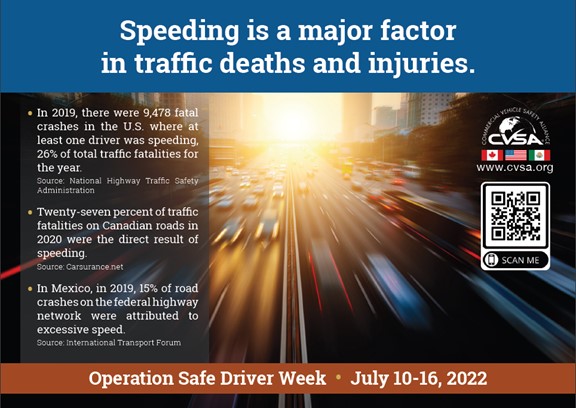Safety is top priority for professional truck drivers, and sharing busy highways is a source of risk. Fatal crashes involving trucks were up by 13% in 2021, according to the National Highway Traffic Safety Administration (NHTSA). This rise creates a risk for drivers of all vehicle types.
Operation Safe Driver Week (July 10-16, 2022) is an educational and enforcement campaign that seeks to reduce risky driving behavior. This Commercial Vehicle Safety Alliance (CVSA) program will feature law enforcement on the road across the U.S., Canada, and Mexico. Officers will be looking for commercial and passenger vehicle drivers who exhibit dangerous driving habits.
Just like last year, the focus of Operation Safety Driver Week will be speeding—a major factor in traffic-related casualties across North America.
Alarming rise in U.S. fatal crashes
Traffic stats show a continued rise in fatal accidents this decade. In 2020, the NHTSA reported a 17% rise in speed-related fatalities. A year later they reported a 13% increase in fatal truck crashes. In 2022, the CVSA reports that fatal crashes have increased by 6.8% although crashes and traffic injuries have declined.
Fewer crashes and more fatalities point to speed as the reason for more deadly U.S. traffic crashes. Studies also show that it doesn’t take much extra speed to increase the danger of serious injuries and death.

Why is speeding so deadly?
It doesn’t matter what type of vehicle a driver operates. Speeding creates danger in several ways:
- Increased braking distance
- Less time to react for drivers, cyclists, and pedestrians
- Reduced effectiveness of airbags and seatbelts
- Reduced vehicle control
- Greater force of impact
The last point is crucial to understanding the role of speeding in traffic deaths. A 2016 study showed that the rate of fatality and serious injury starts rising quickly at around:
- 18 mph (30 kph) for collisions with pedestrians or cyclists
- 31 mph (50 kph) for side collisions
- 43 mph (70 kph) for head-on impacts
Truck collisions create a devastating impact
The typical weight of a U.S. truck is 80,000 pounds, compared to 4,150 pounds for passenger vehicles. This means that the average truck collides with 19 times more energy than the average car traveling at the same speed, emphasizing the importance of truckers reducing speed.
“The rising fatalities on our roadways are a national crisis. We cannot and must not accept these deaths as inevitable,” said U.S. Transportation Secretary Pete Buttigieg.
Telematics help reinforce fleet safety culture
Companies can use truck telematics data to establish and maintain a strong fleet safety culture. Telematics systems collect data in real time, providing detailed information about each driver’s behavior. At the same time, the system gives you a comprehensive view of company-wide operations and assets.
This data helps to guide vehicle training and maintenance efforts, and validates the effectiveness of your safety policies. Telematics also provide a powerful communication tool that facilitates positive interactions between your drivers and office staff. Everyone can play an active role to improve safety for the entire fleet.
Real-time coaching for drivers is key. Addressing risky behavior as it happens increases driver awareness and improves safety habits. Telematics technology, such as the ISAAC Coach, monitors speed, acceleration, hard braking, and sudden turns in real time, with the ability to alert drivers without distracting them. When risky behavior isn’t addressed right away, drivers are less likely to commit to safety improvements.
Sometimes, drivers need a quick reminder to keep eyes on the road, hands on the wheel, and their head in the game. In other cases, in-depth training and follow-ups may be required. Safety is an everyday issue year round—not just during safety week. Telematics make it easier to continually improve and strengthen driver safety.
Find out how ISAAC can become your partner in building and maintaining a strong safety culture within your fleet.


